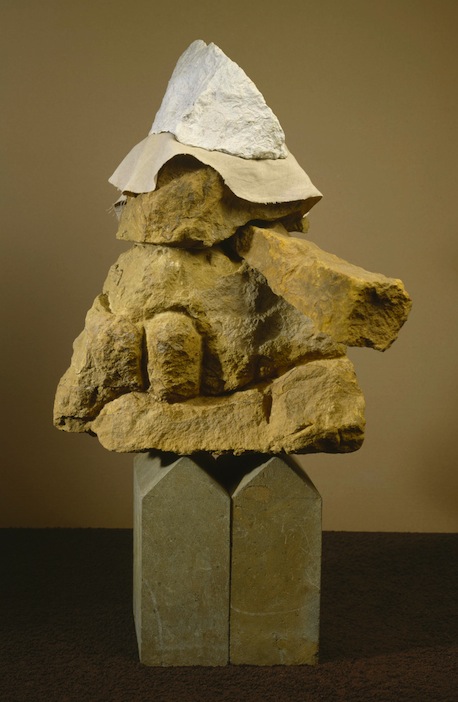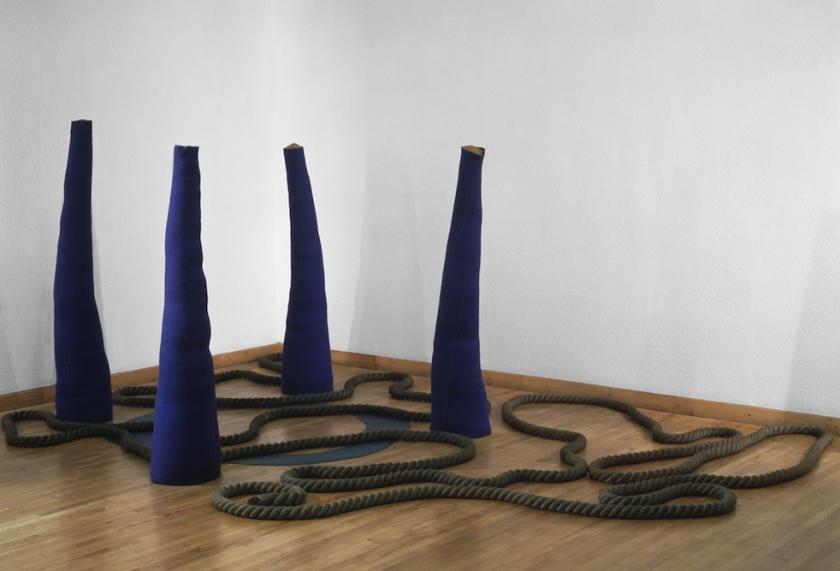"The sheer adventure and life of the touch is the only relevancy," wrote Barry Flanagan in his graduation thesis for St Martin’s School of Art in 1966. "I must allow my hand to touch and feel, my eyes to look and see, my tongue to lick and taste, my nose to sniff and smell, my ears to listen and hear."
Clearly a sensualist, his approach to art-making was exploratory; a fascination with materials and processes led to objects whose forms were arrived at through simple actions that are clearly visible in the end product. The first sculptures in this exhibition at Tate Britain are made from sand. Poured onto the floor, a small heap is hollowed out at the apex like a volcano; having gently come to rest, the particles remain in place without coercion. Poured into cheesecloth tubes, though, they struggle to escape and stretch the loosely woven fabric to bursting point. Canvas is stronger and more resilient; able to control its unruly contents, the canvas pyramid, al casb 4 (1967), can be left open at the top to reveal the sand inside and explain the slight sagging of the sides.
These lessons in gravity may sound banal, but there’s a playfulness to Flanagan’s approach that makes his explorations endearing. The cheesecloth rounds are as inviting as a pair of luscious breasts and, stained blue, the canvas pyramid reminds one of sea, sky and sand; resting on the sand is an aluminium scoop, like an invitation to play.
Imagine the sense of outrage I felt on first encountering Tantric Goddess (1973); an artist I took to be a radical spirit had switched to a traditional craft
Next came a variety of sand-filled cones resembling tube worms from the murky depths; wobbly outlines indicate unstable contents, which makes their height and thinness even more impressive. Associations with the sea are strongest in an installation in which heavy rope winds between four bright-blue cones over a ring of blue lino shaped like a puddle. The presence of sand, canvas, ropes, bollards and shapes evoking water conjures thoughts of yachts and harbours, sea and sand.
Heaped in piles, the hessian sausages carry no such associations. The way they lie is determined by their contents. Those filled with sand droop heavily down, succumbing to gravity with a leisurely abandon that is surprisingly satisfying; those filled with lighter materials, such as rope or string, have bumpy outlines and are too light fully to surrender.
 A heap of sacks fills one corner. A shaft of bright light cuts a swathe across this lumpen pile. Light on light on sacks (1969) is about contrasts – weight versus levity, dullness versus brilliance, bulbous form versus clear geometry and, by implication, inertia versus energy, matter versus spirit, body versus intellect – except that Flanagan’s work is poetic rather than didactic and its message, if any, is elusive. To be effective the installation needs low lighting, but sadly the room is filled with daylight.
A heap of sacks fills one corner. A shaft of bright light cuts a swathe across this lumpen pile. Light on light on sacks (1969) is about contrasts – weight versus levity, dullness versus brilliance, bulbous form versus clear geometry and, by implication, inertia versus energy, matter versus spirit, body versus intellect – except that Flanagan’s work is poetic rather than didactic and its message, if any, is elusive. To be effective the installation needs low lighting, but sadly the room is filled with daylight.
Flanagan was one of many artists, in the late 1960s, who concentrated on processes rather than products and made work that seems provisional because it doesn’t arrive at a conclusion. He began exploring painting as a medium, for example, but instead of attaching canvas to stretchers, hung bits of hessian from rods like samples or draped it over branches to create structures resembling wigwams and funeral pyres.
Imagine the sense of outrage I felt on first encountering Tantric Goddess (1973), a stone carving of a woman lying on her back, legs splayed with her vagina, nipples and lips outlined in red. It was like a betrayal; an artist I took to be a radical spirit had switched to a traditional craft and turned into a male chauvinist! Flanagan had visited the marble quarries in Pietrasanta, Italy and become interested in working with stone.
All was not lost, though. In sculptures like Ubu of Arabia (1976) (pictured above right) his playful inventiveness is still apparent; rough chunks of hornton stone are piled on top of one another to produce a comic head with a long nose, wearing a white hat with a floppy canvas brim. He is based on Alfred Jarry’s Ubu Roi, an absurdist character whom the artist had long identified with; with almost miraculous sleight of hand, Flanagan achieves the apparently effortless marriage of abstract and figurative impulses. (His wonderfully observed drawings of people, birds and landscapes reveal that Flanagan could have been a fine figurative artist).
It was only a matter of time before he began making maquettes for professional carvers to scale up into larger works. Some of the results are weirdly paradoxical. Untitled ‘2b x 4’ (1982) originated as a diminutive twist of clay between the artist’s fingers. The appearance of softness has been retained in the marble version, but it makes the carving look as if it has lost definition, like a used bar of soap.
 If translation from clay into marble seems forced, the transition from clay into bronze has a long and illustrious history. Flanagan’s first bronze cast of a leaping hare was produced from a clay prototype in 1980 and from then until his death in 2009, he produced bronze hares mischievously cavorting in every conceivable fashion. They enjoyed enormous popularity, but stifled the habit of restless enquiry that had once made his work so provocative. The exhibition ends with Leaping Hare, Embellished (1980) (pictured above) and Large Leaping Hare from two years later, so drawing a convenient veil over the last 17 years of his output and his decline into the charm and whimsicality that were always present but, thankfully, were held in check until the final decades.
If translation from clay into marble seems forced, the transition from clay into bronze has a long and illustrious history. Flanagan’s first bronze cast of a leaping hare was produced from a clay prototype in 1980 and from then until his death in 2009, he produced bronze hares mischievously cavorting in every conceivable fashion. They enjoyed enormous popularity, but stifled the habit of restless enquiry that had once made his work so provocative. The exhibition ends with Leaping Hare, Embellished (1980) (pictured above) and Large Leaping Hare from two years later, so drawing a convenient veil over the last 17 years of his output and his decline into the charm and whimsicality that were always present but, thankfully, were held in check until the final decades.
- Barry Flanagan: Early Works 1965-1982 at Tate Britain until 2 January, 2012









![SEX MONEY RACE RELIGION [2016] by Gilbert and George. Installation shot of Gilbert & George 21ST CENTURY PICTURES Hayward Gallery](/sites/default/files/styles/thumbnail_125_x_125_/public/mastimages/Gilbert%20%26%20George_%2021ST%20CENTURY%20PICTURES.%20SEX%20MONEY%20RACE%20RELIGION%20%5B2016%5D.%20Photo_%20Mark%20Blower.%20Courtesy%20of%20the%20Gilbert%20%26%20George%20and%20the%20Hayward%20Gallery._0.jpg?itok=3oW-Y84i)





Add comment